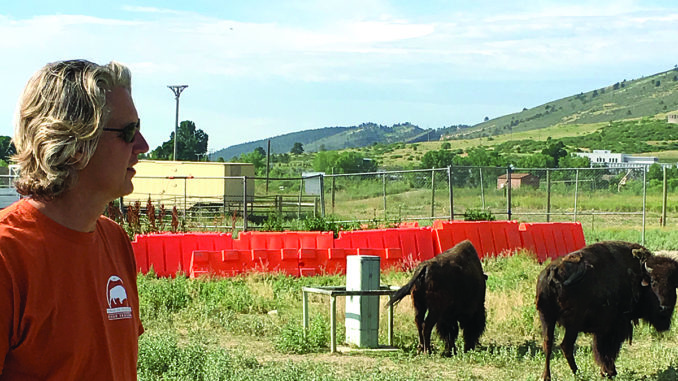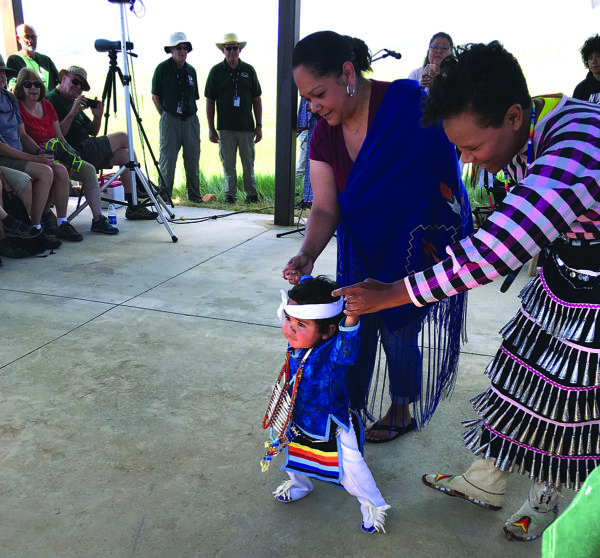
By R. Gary Raham
“The bison are really thriving at Soapstone right now,” said wildlife biologist Matt McCollum near the pens housing the animals that will soon join the 76 bison currently at the natural area. “Two-year-old females are calving this year.” Typically bison have their first young at three. The Laramie Foothills Bison Conservation Herd, as it is officially known, has grown quickly from the ten animals introduced in November 2015. Dr. Jennifer Barfield, assistant professor in the College of Veterinary Medicine and Biomedical Sciences, developed the assisted reproductive techniques for cleansing the genetically pure Yellowstone bison stock of the disease Brucellosis, dangerous to both humans and cattle.
Many Northern Colorado residents had a chance to see bison at home on the Soapstone range on July 13 when Colorado State University, the City of Fort Collins and Larimer County helped celebrate the natural area’s tenth year of existence. The herd often seems tiny on its thousand acres of real estate. McCollum explained that CSU conservatively estimates the carrying capacity of the property to be 100 bison, “Although this year, with the added moisture, perhaps five hundred animals could live there,” he added.
Bison suffered near extinction in the 19th century from overhunting that may have been at least partly political. The United States was at war with Native American nations whose livelihood depended on bison. Reducing bison numbers made Native American resistance to Western expansion much harder. Native American dancers participating in the anniversary event brought a message of both conservation and spirituality with them. A healthy bison population reflects the health of the prairie because the bison represent a vital component of the prairie ecosystem. The bison also represent, for Native Americans, spiritual connections to ways of life that stretch back more than ten thousand years and 600 human generations.

Back in the day when bison teetered on the brink of extinction, farmers and ranchers made different decisions on how to save a few of these amazing animals. Some tried breeding them with cattle, with somewhat limited success. Most of the half million or so bison in the U.S. have a few percent of cattle genes lingering in their genomes, just like people of Northern European descent harbor about 2% Neanderthal DNA in theirs.
A few farmers and ranchers sent pure bison to Yellowstone where they survived until Barfield’s techniques freed them of disease and provided a new source of diversity to existing conservation herds scattered over the continent. A couple of bulls recently left Soapstone to sire calves that would eventually find their way to Blackfeet Nation land in Montana.
In some places humans and bison still have trouble co-existing. The Summer 2019 issue of National Parks magazine, for example, describes how a frontiersman named Charles Jones assembled a bison herd with a Galloway cattle admixture near Grand Canyon—perhaps in an area where bison weren’t native to begin with. Descendants of that herd now threaten to destroy sensitive Grand Canyon meadows. Park officials hope they can relocate animals to more appropriate, happy homes.
Researchers Dr. Liba Pejchar, Dr. Melinda Smith, and post-doc Kate Wilkins are studying differences at Soapstone between portions of the prairie occupied by bison and portions still grazed by cattle to note any ecological differences. Such studies take time and money. Currently, because funding ran out for their studies, the researchers are volunteering time to maintain their records. One surprise so far is that Horned Larks and Grasshopper Sparrows tend to prefer the company of bison while Vesper Sparrows and lark Sparrows are more prevalent on cattle grazing sites. Scientists hope careful observations will connect the dots to animal/plant relationships and how they maintain a healthy prairie.
At the moment, this unique bison herd is content on its thousand acres of Soapstone Prairie, completely at home on the range, and providing us with glimpses of deep history in Northern Colorado.
Support Northern Colorado Journalism
Show your support for North Forty News by helping us produce more content. It's a kind and simple gesture that will help us continue to bring more content to you.
BONUS - Donors get a link in their receipt to sign up for our once-per-week instant text messaging alert. Get your e-copy of North Forty News the moment it is released!
Click to Donate
